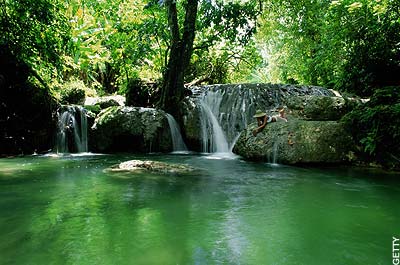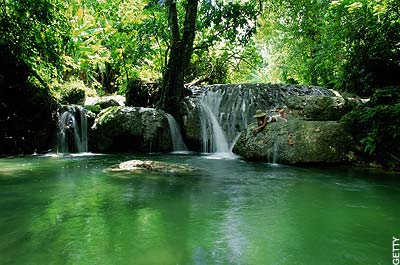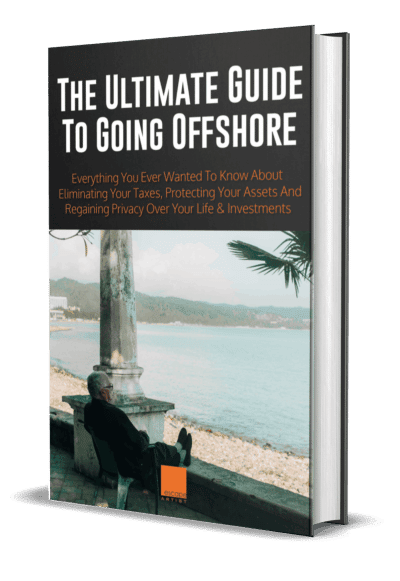An unspoiled, tribal way of life still holds sway in the South Pacific islands of Vanuatu. But, as Nick Squires is relieved to discover, they don’t eat visitors any more.
A dozen semi-naked men ululated in a jungle clearing as the ticklish business of how best to cook a human being was patiently explained to me.
“First, our ancestors would dig a hole in the ground like this,” said villager Berna Kambai, using his finger to draw a rectangular shape in the sand. “They’d put hot stones in the hole, then cut up the person into pieces and put those on top.
They’d add in some yams and taro, put in some more hot rocks, and cover it all over with banana leaves to keep the steam in.”
Standard baking time for the underground oven was three to five hours. And the chief of the village always got to eat the victim’s head. ”
We’d kill and eat people who stole our women or came to fight us, but we don’t do that any more,” said Kambai, stifling a high-pitched titter. “We feel very sorry for those people now.” Another giggle.
His contrition wasn’t very convincing. Most anthropologists agree that Vanuatu’s last recorded cannibal killing was as recent as 1969, and that it took place on the island of Malekulu, one of 83 which make up the South Pacific nation of Vanuatu – and the venue for this unexpected cooking class, which took place in the island’s South West Bay.
Until independence in 1980, Vanuatu was an Anglo-French colony known as the New Hebrides – the name coined by Captain Cook, who explored the archipelago in HMS Resolution, sailing past this very bay in August 1774.
On one island, fearing imminent attack by up to 1,000 tribesmen, he ordered the ship’s cannons and muskets to be trained on the crowd. The locals were not intimidated. “One fellow shewed us his backside in such a manner that it wasn’t necessary to have an interpreter to explain his meaning,” Cook wrote testily in his log.
The islanders developed a reputation as fearsome cannibals. In 1839 the first two British missionaries to be dispatched from the London Missionary Society were promptly killed and eaten on Martyrs’ Island, now known as Erromango.
Two hundred years on, cannibalism is gone and the locals are anything but hostile. Even so, the tide of modernity has barely lapped at Vanuatu’s shores.
The country is still profoundly traditional, with 80 per cent of people living in thatched hut villages and growing their food in tiny garden plots surrounded by jungle so green it looks as though the leaves are lit from within.
Most of the islands are blanketed in thick rainforest, belief in sorcery and black magic is widespread and a few tribes still wear little more than grass skirts and nambas, or penis sheaths.
You can travel for hours and not see a village, jetty or any sign of human habitation. When islanders have a load of copra to sell, they light fires on the beach to attract passing trading ships.
The archipelago is scattered over an 800-mile axis and roads are poor, so unless you’re a round-the-world yachtie, the best way to reach the more far-flung corners is to take an organised cruise.
Not the sort that offers a dozen different bars and nightly cabarets, but a boutique expedition cruise. I spent six days aboard the Oceanic Discoverer, a small Australian-owned ship, which accommodates a maximum of 72 passengers, although on our trip there were half that number.
The OD, as the crew call it, is equipped with a specially designed excursion vessel – the Xplorer, which is lowered into the water on a hydraulic platform, making beach landings quick and easy.
There is also a glass-bottomed coral viewing boat and a couple of Zodiac inflatables for divers and snorkellers. All this enables the ship – which also cruises Papua New Guinea, the Solomon Islands, New Zealand and the uninhabited Kimberley Coast of northern Australia – to reach areas inaccessible to the big cruise ships.
The cabins are comfortable, with large windows facing out to sea, and the atmosphere on board is casual in a very antipodean way. “We don’t dress up around here,” said the Australian expedition leader, Jamie Anderson, during a familiarisation talk. “If you want to go barefoot, please feel free – even at meal times, it’s absolutely fine.”
The cruise starts in Port Vila, the compact capital of Vanuatu, an unlikely blend of traditional Melanesian and metropolitan European influences. On one side of the main street, Afro-haired women in colourful, puffy shouldered “Mother Hubbard” dresses, introduced by 19th-century missionaries, sell yams, pineapples and squealing piglets in a large market.
Across the road, French expatriates sip café au lait at the Péché Mignon restaurant, which produces exquisite chocolates and crusty baguettes. Bus stops are marked “Arret” and most of the street names are Francophone, from avenue du Général de Gaulle to rue Bougainville.
We steamed out of Port Vila harbour – one of the prettiest in the Pacific – on the evening of the first day, sailing into a perfect sunset as the Oceanic Discoverer headed west and then north.
By next morning we had anchored in a bay off the coast of Ambrym, famed as a centre of black magic and sorcerers, known in pidgin English as “man blong majik”.
“They’re well trained in sorcery – we tend to keep them at arm’s length,” said Fred Toka, an authority on traditional culture and a guide aboard the ship.
Village women greeted us and draped floral leis around our necks as we trekked up a blisteringly hot, black sand beach into shade cast by enormous banyan trees.
The black sand comes from Ambrym’s two lively volcanoes – Mt Marum and its twin, Mt Benbow – the pair of them surrounded by forbidding gullies and ridges.
A string band of men in tropical-print shirts warbled in heavily accented English “We are living in paradise, please relax and enjoy your stay.” One of them picked out a tune on a bush bass – a skiffle-style converted tea chest.
Anywhere else and it would have seemed contrived. But this was only the third time that Oceanic Discoverer had visited the village, and no other cruise ship or tourist operator goes there. The melodic greeting, and the smiles, were genuine.
As was the traditional “Rom” dance the men put on for us. Dressed head to toe in thick, rustling cloaks made of dried banana leaves, their faces obscured by triangular, intricately painted masks, a dozen men stamped and danced on the soft black earth.
A pair of wiry elders bashed out a booming rhythm on a huge, 9ft-tall “tam tam” slit drum, as muscular men with leaf fronds wedged between their buttocks moved in and out of the cloaked dancers.
The next morning found us in a picture-perfect bay, opposite the village of Asanvari, on the island of Maewo. We were welcomed by the local chief, Nelson, and a group of men wearing boat-shaped feather headdresses and seed rattles in Asanvari’s grandly named “yacht club” – a thatched roof hut.
A walk around the village revealed flower-lined paths, neat vegetable patches and gorgeous dark-skinned toddlers with startlingly blonde afro hair.
I fell in with a villager, Frank Siehi, who took me on a chest-pounding trek up a steep hillside and taught me how to greet people in the local language – one of more than 100 found in Vanuatu, making it per capita the world’s most linguistically diverse nation.
Good morning seemed to be “runny” while good afternoon was an even less plausible “bongy”. I wondered if he was taking the mickey, but he seemed genuine enough.
Vanuatu’s quaint Bislama pidgin is a constant joy, although its childish simplicity can sometimes evoke the dialogue of a 1950s Tarzan movie. “Mi no savee” means “I don’t understand”, while a seagull is “pigeon blong solwota” [literally, a saltwater pigeon]. Prince Charles is known as “nambawan [number one] pikinini blong kwin [queen]“.
The afternoon’s snorkelling off Asanvari was superb – the water was as warm as a bath and visibility extended to more than 50ft, revealing brightly coloured fish flitting around giant coral heads.
Later, as I read up on Cook’s travels, I glimpsed a glossy arched back breaking the surface of the water. It was a dugong, or sea cow, plentiful in Vanuatu, but endangered in many other parts of the world.
After leaving Maewo we spotted a pod of pilot whales, their black dorsal fins slicing through the silky sea, their spouts emitting smoky puffs of spray.
We steamed across a channel to the island of Ambae, the inspiration for James Michener’s mythical Bali Hai in Tales of the South Pacific. In a scalloped bay, a rusted island trading vessel unloaded its cargo in a scene worthy of Conrad, muscular island men perched nonchalantly on its gunwales.
Huge, leathery-winged flying fox bats flapped lazily overhead, like tropical vampires. The bats, considered a local delicacy, hung upside down like fruit pods from guano-streaked casuarina trees. “This an area where it’s best not to look up with your mouth open,” said Anderson.
The next day we reached neighbouring Espiritu Santo, its curiously Iberian name conferred by the Portuguese explorer de Quiros in 1606. We found we had one of the South Pacific’s most renowned strands, Champagne Beach, all to ourselves.
It was a relief – the stunning horse-shoe of sugar-fine sand is popular with the big cruise ships, which can deposit up to 2,000 day-trippers at a time.
Delicate wild orchids grew on the moss-draped boughs of giant hardwood trees and a tiny beach bar made from corrugated iron and driftwood offered ice-cold beers, even though it was only 8am.
That afternoon, sailing along the thickly forested coast, we reached one of the world’s most unusual dive sites. The USS President Coolidge was a 650ft-long luxury liner which was converted to a troop ship during the Second World War.
In 1942 it was carrying 5,000 men when it hit two American mines in Santo Harbour, near the dusty colonial outpost of Luganville. The captain managed to ground it on a reef, allowing all but two of its officers and men to wade ashore before the giant vessel slid beneath the waves.
It’s now one of the most acclaimed wreck dives in the world. Divers encounter trucks, Jeeps, chandeliers, cannons and a swimming pool as they explore it.
I slept like the dead that night and woke up just as Oceanic Discoverer nudged its way into South West Bay, where we encountered Berna Kambai. His lurid tales of underground ovens and cannibal raids were not only entertaining, they also rang true.
The island was once famed for the aggressiveness of its tribes. One of the most feared was the Big Nambas – so called for the large red nambas that the men wore. “We’ve adopted Christianity now and we wear clothes but when we dance we go back to the old ways,” said Berna, as a column of bare-chested men in towering masks stamped up the beach, singing and whooping.
The 3ft-tall masks were decorated with pig tusks and cockerel feathers, and miniature replicas were carried by small boys, their brows furrowed with concentration.
“There’s no more war between the tribes – as you can see, we’re very friendly,” said Berna.
He was right – internecine warfare seemed like ancient history as a teenage girl placed another floral lei around my neck, children scampered in the warm shallows and a leathery old man waved us goodbye. “Tank you tumas [thank you very much] for coming to see us,” he said in pidgin, a large red hibiscus tucked daintily behind his ear.
These days the only danger of being baked in Vanuatu is if you lie out in the tropical sun for too long.
Like Our Articles?
Then make sure to check out our Bookstore... we have titles packed full of premium offshore intel. Instant Download - Print off for your private library before the government demands we take these down!






